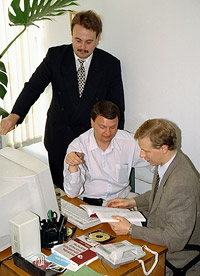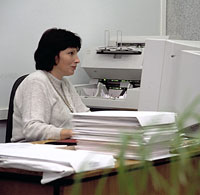
|
From the first days of its work, the Eurasian Patent Organization has been paying close attention to the development of the most advanced information technologies and to the examples of their successful implementation in national and regional patent offices.
It was essential, as the first step, to implement the technological minimum to fulfill the Eurasian legislation requirements. One such requirement is periodic publication of information on Eurasian patent documents. Thus, the development and implementation of technology that would allow publishing such information was an urgent issue at the initial stage of the Organization's activity. Upon the consideration of various alternatives a decision was made to prepare the Organization's official publication internally, using its own facilities. Urgent issues, in addition the organizational and technical ones, included the observation of standards, error-free text entry and proofreading, and strict adherence to the publication schedule. Qualified experts were invited to set the publication process and to solve the above problems.
Scanning and digitalization (recognition) of patent documents was taken as the core technology. Upon developing the overall concept of preparing materials for publication, state-of-the-art workstations were acquired for scanning, digitalization, editing and proofreading of texts, plus a powerful graphic station and a professional printer for the processing of graphic information, layout, and preparation of transparencies. Software for all stages of the publishing process was installed, with preference given to software products that allow the automation of repetitive actions, thus significantly reducing manual work while improving the output quality. EAPO does the full cycle of pre-press work using its own resources up to the blueprint and transparencies. Since the acquisition of high-capacity printing equipment remains uneconomical, the decision was made to outsource printing from prepared transparencies, which ensures full control over the content of the materials being printed and allows for economically effective printing of the required quality.
By 1997-98 the technology was fully developed, and the first publication printed using this method was the EAPO Bulletin No. 1 for 1998. Following that the process of preparation of official publications became even more automated, with this automation achieved by standard methods using the available software.

|
From the time the first issue of the Bulletin was fully prepared within EAPO, its average volume had grown from 11 to 20 quires. A total of over 4000 patent documents have been published since 1996, plus information materials of the Organization.
Presently the Information and Search Systems Department publishes the Bulletin "Inventions" (Eurasian Applications and Patents), Descriptions of Inventions to the Eurasian Applications, and Descriptions of Inventions to the Eurasian Patents every 2 months, plus a yearly Index to the Bulletin, and the Annual Report of the Organization.
With the aim of greater economy, implementation of a modern paperless technology has started in 1999, and all descriptions of inventions are now published on CD-ROMs. An expert in the creation of electronic documents was invited for the implementation of the project, and the technology of CD-ROM development has been developed. The main criteria taken into account in the development of this technology: fast implementation, economic efficiency, and the ease of use without the need for training for the user or the necessity to acquired and install any additional software.
Starting with CD-ROM � 3 for 1999, invention descriptions to patents are published in two languages (the interface, referential materials, bibliography and claims are being translated into English).
The Eurasian Patent Office actively participates in the Regional CD-ROM program. By the end of 1999 the technology of CD-ROM recording was modified to prepare materials in the format agreed on with Rospatent, which is this project's coordinator. As a result of these efforts the pilot issue of the Regional CD-ROM, with information on the Organization's patent documents, was prepared by the beginning of year 2000.
Speaking of the objectives pursued in the development of CD-ROM development and recording technology, it must be noted that the technology thus developed does not allow full text searches among the Eurasian patent resources and does not allow the use of database technologies for the creation of arrays of patent information and manipulating them. In connection to this, it was decided to develop our own automated system for the preparation of the Organization's official publications intended for reliable storage of all materials used in the preparation of the Organization's official publications, such as packages of scanned pages, files with bibliographical data in Russian and English, files with full descriptions, title pages, bulletin blueprints and so on. In addition, the system allows making the business process of publication preparation more orderly because it contains the schemes of document routing inside of the department and manipulates the documents on the base of these schemes, and also permits automating several standard operations involved in document processing on each workstation. It is important that the system will be built on a full-text database and will permit document searches while taking into account the Russian and English morphology. In addition to our own databases, the system will interact with the Common Software document processing databases used in EAPO.
Work is actively underway on this project. The plan is to run the test version of the System in September 2000. In the future the System will permit searching and viewing of Eurasian patent documents via a Web interface. This will make the databases of Eurasian patent documents accessible to all the Internet users.
The understanding that fast and efficient access to quality information is one of the key elements in the work of any patent office resulted in the development of several plans related to telecommunications in EAPO.
Even when initially planning just the computerization of the Office, the need to eventually join all computers into a network was taken into account. Such a network was soon established, and it is successfully functioning.
The first project related to direct access to patent information was to enable the EAPO examiners to conduct real-time searches in the EPOQUE1 and EPOQUE2 databases of patent documentation of the European Patent Office. Data is exchanged via the ISDN line. EAPO has a dedicated workstation for such searches, and examiners training has been conducted. The European Patent Office not only provided access to its information bases free of charge, but also partly reimbursed the cost of traffic via the ISDN channel. Since November 1998 the system has been put into full use, and presently it is functioning successfully, which significantly simplifies the work with referential patent documentation indicated in the international search reports for the EAPO examiners.
The second major telecommunications project implemented in the Organization in the beginning of 1999 was Internet access from every workstation for the Office employees. Patent-related Internet resources accessible via the Web interface are of significant interest to the examining subdivisions of EAPO and are actively used by them. In addition to EAPO's examining subdivisions, Internet access is widely used by other divisions and services of EAPO.
In addition to Internet's on-line resources, the EAPO employees actively use electronic mail as the fastest and most advanced method of sending and receiving text or graphic information. A dedicated mail server has been installed in the EAPO, and each employee received his or her own address in the EAPO.ORG domain.
Availing the Internet access to the employees of EAPO has resulted in a significant improvement in the quality of patent documentation searches, reduction of the required time, and intensification of the information exchange with other offices, including those of the EAPC member states. In addition, using patent information sources in the Internet significantly reduced the cost of patent information searches elsewhere.
In addition to this project, EAPO has developed its own Web server, which contains general information on the Organization, its history, activity, and the latest news, in English and Russian. Documents of the Eurasian patent legislation, information for applicants, information on the Eurasian Patent Convention member states, and links to the sites of other organizations that work in the area of industrial property protection are also widely represented on the server. On the request of plenipotentiary representatives of the EAPC member states, the server contains a constantly updated database with information on the status of Eurasian patents in each EAPC member state. Plenipotentiary representatives of the member states have a free of charge access to this database. In addition, the Organization's website contains an freely accessible database on patent attorneys in each of the member states. For the convenience of the users the Organization's website server, located in the USA, has a "mirror" in Russia. This server is housed in the EAPO building and connected to the EAPO Internet channel.
The development of the EAPO website stimulated interest in the Eurasian Patent System thus expanding the circle of potential applicants. EAPO regularly receives electronic mail with questions, comments and proposals from the site's visitors, and is engaged in intensive correspondence.
As the 5-year anniversary was approaching, the Organization began implementing the program of helping national patent offices in developing their own websites. Under this program the Organization plans to render assistance to national patent offices in the acquisition of equipment, developing the concept and design, registration of domain name, locating it on a server, and subsequent support. Recommendations of the WIPO Standing Committee on Information Technologies, the Organization's experience, and the wishes of a national office for which the site is developed will be taken into account. It must be noted that the Organization reserves for itself the organizational and advisory role in this project. Copyrights for all the materials on these Web sites and their designs will belong to national patent offices only.
The first stage of the project was completed by the middle of 2000 - a modern personal computer with a modem to be used for the preparation of materials for the Web server and uploading them onto the Web server was made available to each national patent office. As part of this stage of the project EAPO also installed and set up a server for hosting national office websites. Thus, a single Eurasian patent area has been created within the Internet, with information accessible from anywhere in the world.
The Organization plans to continue its work on projects in the area of modern telecommunication technologies.

|
The amount of information transmitted daily through the EAPO local network is growing, so the plan for the nearest future is to increase the network's capacity by the factor of 10 to 100 MBit/sec. This upgrade will not require any sizable financial input or serious preparation because all the recently acquired equipment was selected with this planned upgrade in mind.
Since a significant increase in the load onto the EAPO Internet channel is possible in the very near future when EAPO and national patent office Web servers begin working, the plan is to double the capacity of the EAPO Internet channel.
The plan is to soon expand the range of information housed on the Organization's website by arranging access to the database of Eurasian documents. A full-text search mechanism will be implemented. In the course of this project's progress, information from national patent offices will be gradually added to the patent document database.
The Internet portal of Eurasian patent information, with regularly updated news, discussion groups, hotline, etc. is to become a logical sequel to the development of the websites of the national patent offices and of the Organization.